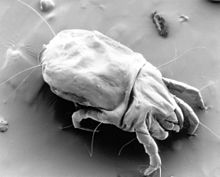Do you have lungs? Would you like to keep them? Good. (You and me both!)
Air is the one thing you can’t live without, and airborne pollutants are the ones you usually can’t see. So let’s chat about the indoor air quality of your camper.
I have good news and bad news.
The bad news is that RV indoor air quality is usually mediocre, there are no enforced codes or universal testing standards, very little OEM innovation, and DIY solutions are time-consuming.
The good news is I saved 15% or more on my car insurance.
>> This is Part 2: Waging War Against the Allergens, Dust, and Pet Hair Inside Your Camper!
Mugshots: Meet the Enemies of Clean Air
We all want clean, pure, fresh air in our RVs and campers! Unfortunately, we wage war against three enemies:
We’ll talk more about these in greater depth in Parts 2, 3, and 4 of this series on RV indoor air quality.
Allergens and Dust
What Are Common Allergens in Campers?
(Don’t eat lunch while reading this article. Because this next fact is super gross.)
After two years, about ⅓ the weight of your pillow is dust mite poop and dead skin.
Here is a dust mite selfie:

Yup, those are the little critters that skitter around your skin at night, feeding on your dead skin.
Most people with asthma are allergic to dust mites and their fecal matter.
And dust mites are just the tip of the iceberg.
Common house allergens include pollen, dirt, pet dander, dead skin – even the arms, legs, heads, and other body parts from dead flies that you slaughtered with a flyswatter and never picked up.
Anywhere humans go, these allergens follow. That includes your RV.
How Do I Know If I Have Allergens In My RV?
The question isn’t “if” you have allergens in your RV – it’s A) how many you have and B) whether you’re sensitive to one kind or the other.
Allergens often irritate our skin and our sinuses first. If you have any of these symptoms when you spend time inside your RV, it’s a good bet you have environmental allergens.
- Dry or scratchy throat
- Congested or runny nose
- Skin rash or hives
Pets and kids carry lots of allergens – pets especially. If you travel with pets, you should clean religiously. You might even consider vinyl mattress protectors and plastic upholstery for your furniture.
7 Ways to Get Rid of Allergens in Your RV
Do Away with Carpet
My number one recommendation is simple: Get rid of your carpet. The fibers harbor allergens. The longer the pile, the worse the carpet.
There’s a host of other reasons to replace the carpet in your RV as well. It hides water absorption, traps mud and grime, and wears out quickly.
“But Andy,” you say, “I’m leaving for Yellowstone in four days! I don’t have time to replace my carpet!”
I understand. If you’re unable to do major renovation, keep reading for some earlier, easier, quicker solutions.
Wash & Dry Your Bedding
Dust mites thrive in warm, humid, dark, dusty spaces (which is basically every bedroom ever).
You should wash and dry your bedding at high heat weekly. Mites and other microscopic creatures will drown in water and die at high heat (at least 140 degrees).
If you’re a full-timer and don’t have immediate access to an electric dryer, then place your bedding in direct sunlight for at least three hours.
Oh, and choose bedding with a thread count of at least 300.
Dust Away!
Did you know original feather dusters were made of ostrich down feathers? These natural miracles do actually attract dust due to static electricity!
Your $10 synthetic feather duster, on the other hand, does not. It just stirs up the dust into the air and irritates your sinuses. So throw away that $10 duster and use your vacuum’s handheld attachment instead. Or ostrich feathers. Your choice.
Open a Window
Out with the bad, in with the good!
The simplest, cheapest method to improve your RV air quality is to air it out. Even in a regular house, outdoor air 2-5x cleaner than indoor air.
Open two windows, preferably on opposite sides of the camper, and let Mother Nature and physics work their magic. If the RV is inside an enclosed space, turn on a ceiling or exhaust fan to assist in air circulation.
Give Fido a Bath
All your hard work cleaning, scrubbing and vacuuming can be laid waste by a single dirty dog.
So before you embark on your next adventure, bathe your pets.
- Use an anti-dander shampoo.
- Air dry the dog’s coat.
- Brush after bathing and use a pet hair vacuum.
Pot a Plant
6 Did you know Gerbera daisies aren’t just beautiful wedding flowers? They also filter benzene, a known carcinogenic chemical, out of the air!
Now, I’m not suggesting you plant an ivy plant and wait for your RV to turn into Jumanji. Instead, Bill Wolverton, a former NASA scientist, recommends the easy-to-grow golden pothos.
Invest In an Air Purifier
Air purifiers are magical. I love them!
A decent air purifier will have a HEPA filter. These filters are rated to trap at least 99.7% of dust, pollen, mold, bacteria, and other particles with a size of 0.3 microns.
(That’s tiny. A human hair is about 70 microns wide. So imagine splitting a hair into 240 individual hairs!)
Now, please remember that air purifiers are only useful if your doors and windows are closed! Ventilation will just remove all that clean air your purifier worked so hard to produce.
Indoor air filtration is an exciting science! Companies are introducing new chemical, biochemical and mechanical methods. For instance, the PECO filter uses a chemical catalyst that transforms pollutants into nothing more than carbon dioxide and water vapor!
Leave a Reply